Moving on from boring
test sessions, I finally resumed work on the Meng King Tiger proper. But before any oil paint filter/render techniques could be attempted, there was the matter of applying decals on the tank to mark it out as Tank No.124 of the
Schwere Panzer-Abteilung 505 or the 505th German Heavy Tank Battalion. Even so, I did get a start on the oil painting process albeit on a small scale i.e. the left front skirt of the
German Heavy Tank
Sd.Kfz.182 King Tiger (Henschel Turret).
 |
| Meng Model King Tiger work-in-progress: Decals and a clear matt coat |
 |
| Markings on the original Tank 124 as it was found in the war |
With this being my first use of Meng decals, I wasn't too sure about the quality and how they would hold up under the stress of my clumsy hands. And true to form I did encounter problems, initially at least. On my first attempt at applying the 'charging knight' decal, the plume on the knight's helmet tore off and the tip of his lance bend in on itself. Luckily I was in one of my 'in the zone' moments and retained enough patience to more or less fix things (
see 'charging knight' symbol on the left side of the turret; eighth photo from the top). Soon enough though, I got used to the decals' firmness and my hands' muscle memory adapted accordingly. As such, no further decal problems arose.
 |
| Charging knight symbol of the Schwere Panzer-Abteilung 505 (s.Pz.Abt.505) tank unit |
 |
| Zoomed out view of the charging knight symbol on the tank turret |
 |
| Decals denoting this as Tank 124 of the s.Pz.Abt.505 |
Decals have a tendency to stand out in unwanted ways. This is due to their glossy nature as well as visibility of a semi-visible demarcation between the decal material and the surface area sans decal. To improve realism so that decals look like they were painted, I decided to apply a lacquer-based clear matt coat i.e. the
Mr Hobby Mr Super Clear. A note of caution: the Mr Hobby website warns that usage of this lacquer-based clear coat over decals may damage them. Thankfully, this wasn't the case for me. I went ahead despite the warning out of necessity and an analytical guesstimate.
 |
| Decals adhered to the zimmerit layer without any problems |
 |
| Clear matt coat reduces the shine of the decals thus ... |
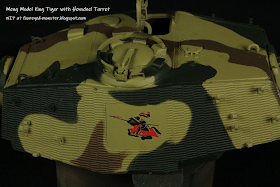 |
| ... making the decals look more like it was painted onto the turret |
Firstly, it was a necessity because usage of water-based clear coats can be a hit-and-miss affair for me. There have been occasions when white spots formed if the spray can of clear coat was too old or if the weather was too humid. I've found this becomes a non-issue if I use lacquer-based clear coats. Secondly, it's my guesstimate that if I apply clear coats in a thin enough layer, then the hot weather would evaporate most of the clear coat's solvent (which would damage the decals) before it hits the surface of the model kit. In the conditions that I work in, which is fairly hot and humid, I can safely conclude that usage of the
Mr Super Clear on top of Meng decals did not damage the latter.
Oil Paint Filter and/or Rendering Process Begins
Having applied the clear coat, I wanted to give the protective layer a few days or even a week to dry in order for it to sufficiently strengthen. This meant I couldn't start the oil dot filter weathering or oil paint rendering process on the tank proper. However, I already had a piece of front skirt clear coated much earlier so I could at least begin the oil painting techniques on that part (
see photos below).
 |
| Results of an oil paint filter/rendering session on the matt surface of the tank's front left skirt |
A
previous foray into this technique didn't yield good results. So something had to change. What I did differently here was threefold namely be more patient; be more particular in the placement of specific hues and be more judicious in the use of white spirit (less is more). A disregard for all three in my previous attempt had resulted in a messy mono-hued filter look. It's actually good I got to start on a small part of the tank first as I'm still unhappy with the results. But with every attempt I am beginning to better understand the oil dot filter weathering and/or oil paint rendering technique.
 |
| Step 01: Part primed with Tamiya Fine Surface Primer (Light Gray) and basecoated with Tamiya TS-3 Dark Yellow |
 |
| Step 02: Oil paints applied as dots onto the part |
 |
| Step 03: Oil paints blended with white spirit |
 |
| Step 04: Results of the oil dot filter weathering / oil paint rendering after a few cycles of steps one through three |
In addition to the three new approaches I used, I also changed the number of times I would apply this procedure. Previously, I would just place the the oil paints, blend it once and then consider my task finished. Now though, I'm doing up to three passes (Steps 01 to 03 above) of oil dot filter weathering and/or oil paint rendering - one on top of the other - until I'm satisfied with the final results.
 |
| Extreme closeups of the before and after oil dot filter weathering / oil paint rendering process |
So then, it's now on to the rest of the tank for the oil dot filter weathering and/or oil paint rendering process. I'm slowly getting a hang of the technique and I'm fairly confident results will be better when I apply this technique on the tank hull and turret, decals and all. And as I make good progress on the Meng King Tiger, I feel confident enough to start a new project in addition to the two I'm working on (the other being the
atelier iT Race Queen). All I'll say at this stage is the new project involves a car and it's one of my top two favorite cars ever. Do enjoy what's left of your weekend and see you soon.
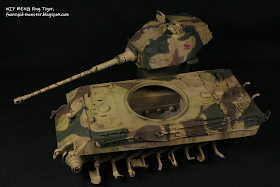
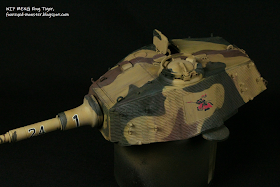


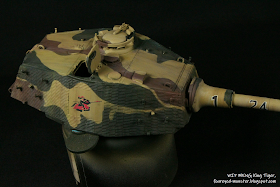



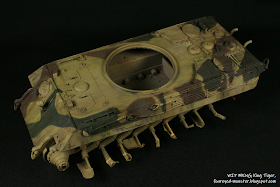
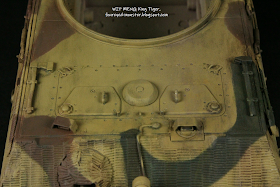
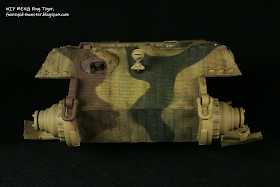
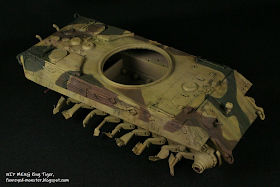

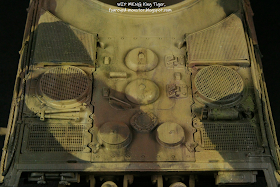
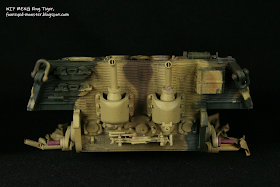
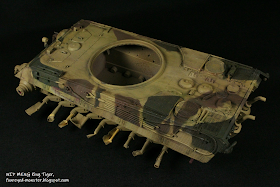
















.jpg)















